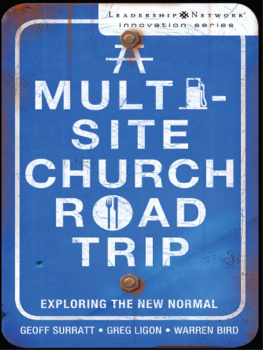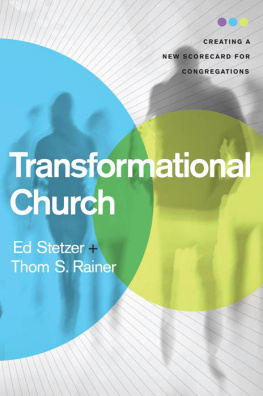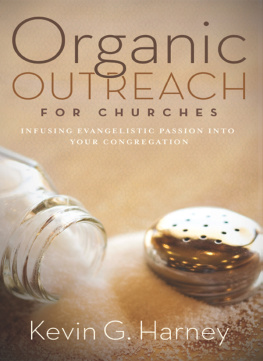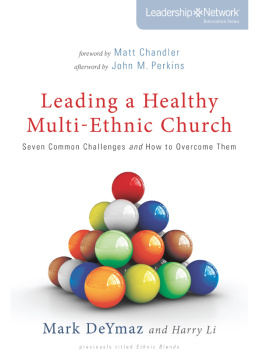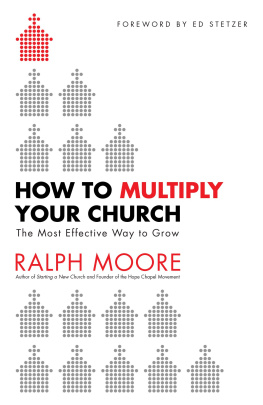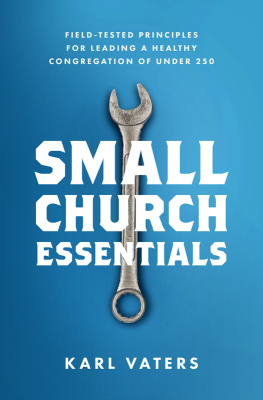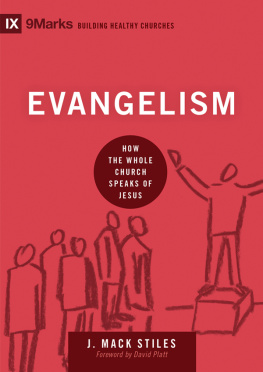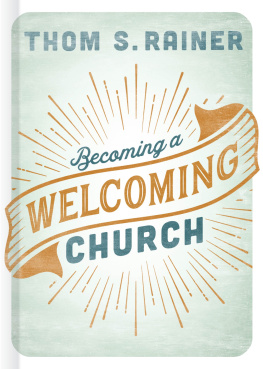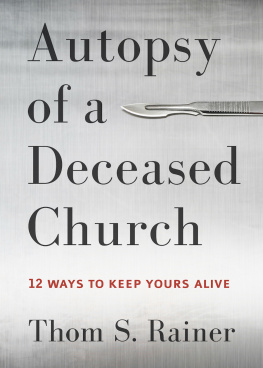
The Leadership Network Innovation Series
The Big Idea: Focus the Message, Multiply the Impact, Dave Ferguson, Jon Ferguson, and Eric Bramlett
Confessions of a Reformission Rev.: Hard Lessons from anEmerging Missional Church, Mark Driscoll
Deliberate Simplicity: How the Church Does More by Doing Less, Dave Browning
Leadership from the Inside Out: Examining the Inner Lifeof a Healthy Church Leader, Kevin Harney
The Monkey and the Fish: Liquid Leadership for aThird-Culture Church, Dave Gibbons
The Multi-Site Church Revolution: Being One Church in ManyLocations, Geoff Surratt, Greg Ligon, and Warren Bird
Servolution: Starting a Church Revolution through Serving, Dino Rizzo
Sticky Church, Larry Osborne
Other titles forthcoming
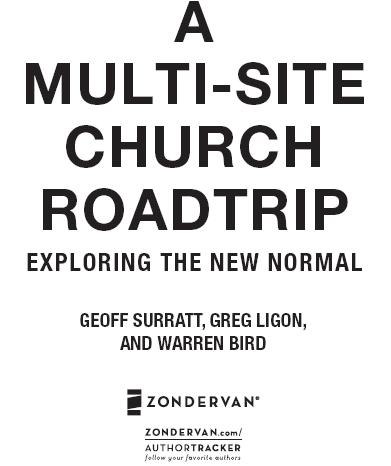
ZONDERVAN
A MULTI-SITE CHURCH ROADTRIP
Copyright 2009 by Geoff Surratt, Greg Ligon, and Warren Bird
All rights reserved under International and Pan-American Copyright Conventions. By payment of the required fees, you have been granted the non-exclusive, non-transferable right to access and read the text of this e-book on-screen. No part of this text may be reproduced, transmitted, down-loaded, decompiled, reverse engineered, or stored in or introduced into any information storage and retrieval system, in any form or by any means, whether electronic or mechanical, now known or hereinafter invented, without the express written permission of Zondervan.
ePub Edition August 2009 ISBN: 978-0-310-32329-7
This title is also available as a Zondervan ebook. Visit www.zondervan.com/ebooks.
This title is also available in a Zondervan audio edition. Visit www.zondervan.fm.
Requests for information should be addressed to:
Zondervan, Grand Rapids, Michigan 49530
Library of Congress Cataloging-in-Publication Data
Surratt, Geoff, 1962
A multi-site church roadtrip : exploring the new normal / Geoff Surratt, Greg Ligon, and Warren Bird.
p. cm. (Leadership network innovation series)
Includes bibliographical references and index.
ISBN 978-0-310-29394-1
1. Church growth. 2. Church facilities Planning. 3. Church management. I. Ligon, Greg, 1962 II. Bird, Warren. III. Title.
BV652.25.S86 2009
254 dc22
2009015940
All Scripture quotations, unless otherwise indicated, are taken from the Holy Bible, NewInternational Version. NIV. Copyright 1973, 1978, 1984 by International Bible Society. Used by permission of Zondervan. All rights reserved.
Any Internet addresses (websites, blogs, etc.) and telephone numbers printed in this book are offered as a resource. They are not intended in any way to be or imply an endorsement by Zondervan, nor does Zondervan vouch for the content of these sites and numbers for the life of this book.
All rights reserved. No part of this publication may be reproduced, stored in a retrieval system, or transmitted in any form or by any means electronic, mechanical, photocopy, recording, or any other except for brief quotations in printed reviews, without the prior permission of the publisher.
09 10 11 12 13 14 20 19 18 17 16 15 14 13 12 11 10 9 8 7 6 5 4 3 2 1
CONTENTS
No longer primarily for megachurches, multi-site campuses range from a few dozen people meeting in a neighborhood clubhouse to thousands of attenders in a brand-new church building.
More people are approaching the issue as both-and rather than either-or. One of the big surprises is how many church planters have embraced multi-site.
A multi-site church is either a church with multiple sites or a church of multiple sites. Making the all-important shift from with to of brings a significant change to the culture of the church. This subtle shift transforms the core identity of the church and will affect everything you do.
Choosing the right location for the next campus is one of the most difficult decisions for a multi-site church. Each churchs vision, values, and context help it shape the strategy that will have the greatest kingdom impact.
Multi-site churches are transforming their communities by contextualizing their service and outreach to the unique needs of each location.
While some debate whether an online campus is really a church, others see the internet as just another neighborhood, filled with people to be reached and where you arent limited by the size of a building.
The infrastructure of a church that meets in multiple locations is often more about bandwidth and uplinks than about bricks and mortar. Balancing budget constraints and technological demands of several campuses is one of the more difficult challenges for a multi-site church.
When a church goes from one campus to many campuses, its organizational chart is stretched to the breaking point. The ability to reorganize quickly is an important skill in the multi-site church toolbox.
The technology and mentality now exists for a church to have a campus in another country thousands of miles away, and many churches are developing a stronger level of missionary partnership in the process.
For a growing number of churches, the primary teaching pastor is hundreds or thousands of miles away. This shift has big implications for the campus pastor and other local staff, in terms of the vision and local leadership roles.
After experiencing their first merger, some churches embrace the idea of pursuing additional, more intentional mergers, often called restarts.
Launching two or more campuses at once can help a church transition more quickly to a multi-site mind-set, as it engages the entire church in the process, creating even greater momentum. But the benefits should be weighed against the costs, since it can put a strain on both financial and human resources.
Good leadership is always the key to healthy, growing churches. That need multiplies and increases in multi-site churches. Effective multi-site churches have an established culture and well-developed strategies for reproducing and growing biblical leaders.
While some say going multi-site is simply a new opportunity to obey Jesus great commission, others raise cautions. Are there biblical values that might be lost or weakened by the multi-site growth model?
Many churches are moving from addition to multiplication as secondary campuses begin launching campuses of their own. This new wave of grandchildren increases the challenges of DNA transfer.
The multi-site revolution is still mushrooming, a new normal is emerging, and the implications are rich for how the next generation will see and do church.
G reg, Warren, and I (Geoff) met in 2003 at Leadership Networks first Multi-Site Churches Leadership Community gathering. As director of that community, Greg had assembled from around the country twelve churches experimenting with the relatively new concept of being one church meeting in multiple locations. Warrens role in the community was to capture what the churches in the group were learning and to share that knowledge with other churches around the country. I came as a member of the team from Seacoast Church in Charleston, South Carolina. At the time, Seacoast met in five locations and was desperate to learn from other pioneers how to make this new paradigm work.
Over the groups two-year life span, Greg and Warren discovered a ground swell of interest from churches wanting to know more about doing ministry in multiple locations under one umbrella organization. Warrens multi-site articles were downloaded by thousands of leaders across North America, and Greg heard from dozens of pastors whose churches were moving to a multi-site model. The two of them began framing a book about this multi-site revolution that seemed to be mushrooming. I came on board to provide insight from what we were doing at Seacoast, as a thread to be woven through the book. As my brother Greg, senior pastor at Seacoast, often says, Everyone is good for something, even if it is to be a bad example. My job in helping write
Next page
